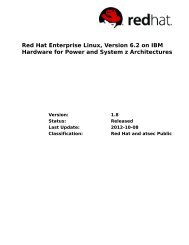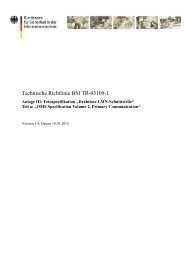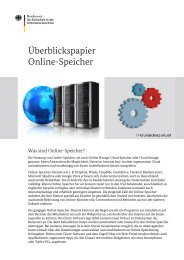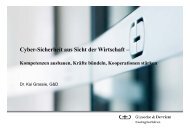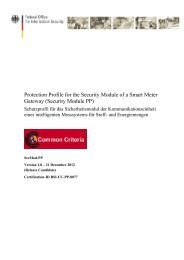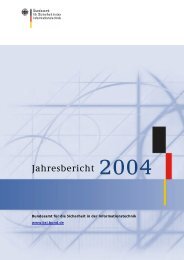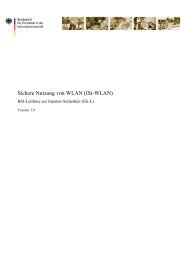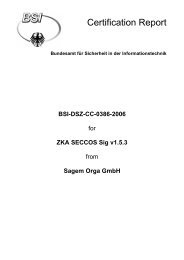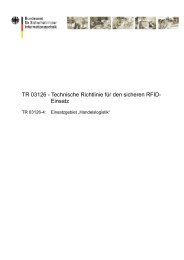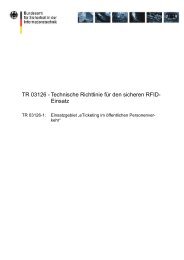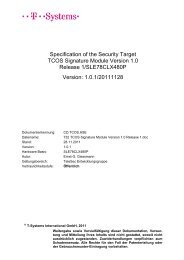Certification Report BSI-DSZ-CC-0177-2002 - BSI - Bund.de
Certification Report BSI-DSZ-CC-0177-2002 - BSI - Bund.de
Certification Report BSI-DSZ-CC-0177-2002 - BSI - Bund.de
Create successful ePaper yourself
Turn your PDF publications into a flip-book with our unique Google optimized e-Paper software.
<strong>Certification</strong> <strong>Report</strong><br />
<strong>Bund</strong>esamt für Sicherheit in <strong>de</strong>r Informationstechnik<br />
<strong>BSI</strong>-<strong>DSZ</strong>-<strong>CC</strong>-<strong>0177</strong>-<strong>2002</strong><br />
for<br />
Philips Smart Card Controller P8WE5033V0F<br />
from<br />
Philips Semiconductors GmbH<br />
Business Unit I<strong>de</strong>ntification
- <strong>Bund</strong>esamt für Sicherheit in <strong>de</strong>r Informationstechnik, Postfach 20 03 63, D-53133 Bonn<br />
Telefon +49 228 9582-0, Infoline +49 228 9582-111, Telefax +49 228 9582-455
<strong>BSI</strong>-<strong>DSZ</strong>-<strong>CC</strong>-<strong>0177</strong>-<strong>2002</strong><br />
Philips Smart Card Controller<br />
P8WE5033V0F<br />
from<br />
Philips Semiconductors GmbH<br />
Business Unit I<strong>de</strong>ntification SOGIS-MRA<br />
The IT product i<strong>de</strong>ntified in this certificate has been evaluated at an accredited and licensed/<br />
approved evaluation facility using the Common Methodology for IT Security Evaluation, Part 1<br />
Version 0.6, Part 2 Version 1.0, exten<strong>de</strong>d by advice of the <strong>Certification</strong> Body for components<br />
beyond EAL4 and smart card specific guidance, for conformance to the Common Criteria for IT<br />
Security Evaluation, Version 2.1 (ISO/IEC15408: 1999).<br />
Evaluation Results:<br />
PP Conformance: Protection Profile <strong>BSI</strong>-PP-0002-2001<br />
Functionality: BSl-PP-0002-2001 conformant plus product specific extensions<br />
Common Criteria Part 2 exten<strong>de</strong>d<br />
Assurance Package: Common Criteria Part 3 conformant<br />
EAL5 augmented by<br />
ALC_DVS.2 (Life cycle support - Sufficiency of security measures),<br />
AVA_MSU.3 (Vulnerability assessment - Analysis and testing for<br />
insecure states),<br />
AVA_VLA.4 (Vulnerability assessment - Highly resistant)<br />
This certificate applies only to the specific version and release of the product in its evaluated<br />
configuration and in conjunction with the complete <strong>Certification</strong> <strong>Report</strong>.<br />
The evaluation has been conducted in accordance with the provisions of the certification<br />
scheme of the <strong>Bund</strong>esamt für Sicherheit in <strong>de</strong>r Informationstechnik and the conclusions of the<br />
evaluation facility in the evaluation technical report are consistent with the evi<strong>de</strong>nce adduced.<br />
The notes mentioned on the reverse si<strong>de</strong> are part of this certificate.<br />
Bonn, 23 August <strong>2002</strong><br />
The Presi<strong>de</strong>nt of the <strong>Bund</strong>esamt für<br />
Sicherheit in <strong>de</strong>r Informationstechnik<br />
Dr. Henze L.S.<br />
<strong>Bund</strong>esamt für Sicherheit in <strong>de</strong>r Informationstechnik<br />
Go<strong>de</strong>sberger Allee 185-189 - D-53175 Bonn - Postfach 20 03 63 - D-53133 Bonn<br />
Telefon (0228) 9582-0 - Telefax (0228) 9582-455 - Infoline (0228) 9582-111
The rating of the strength of functions does not inclu<strong>de</strong> the cryptoalgorithms suitable for<br />
encryption and <strong>de</strong>cryption (see <strong>BSI</strong>G Section 4, Para. 3, Clause 2)<br />
This certificate is not an endorsement of the IT product by the <strong>Bund</strong>esamt für Sicherheit in <strong>de</strong>r<br />
Informationstechnik or any other organisation that recognises or gives effect to this certificate,<br />
and no warranty of the IT product by <strong>Bund</strong>esamt für Sicherheit in <strong>de</strong>r Informationstechnik or<br />
any other organisation that recognises or gives effect to this certificate, is either expressed or<br />
implied.
<strong>BSI</strong>-<strong>DSZ</strong>-<strong>CC</strong>-<strong>0177</strong>-<strong>2002</strong> <strong>Certification</strong> <strong>Report</strong><br />
Preliminary Remarks<br />
Un<strong>de</strong>r the <strong>BSI</strong>G 1 Act, the <strong>Bund</strong>esamt für Sicherheit in <strong>de</strong>r Informationstechnik<br />
(<strong>BSI</strong>) has the task of issuing certificates for information technology products.<br />
<strong>Certification</strong> of a product is carried out on the instigation of the vendor or a<br />
distributor, hereinafter called the sponsor.<br />
A part of the procedure is the technical examination (evaluation) of the product<br />
according to the security criteria published by the <strong>BSI</strong> or generally recognised<br />
security criteria.<br />
The evaluation is normally carried out by an evaluation facility recognised by the<br />
<strong>BSI</strong> or by <strong>BSI</strong> itself.<br />
The result of the certification procedure is the present <strong>Certification</strong> <strong>Report</strong>. This<br />
report contains among others the certificate (summarised assessment) and the<br />
<strong>de</strong>tailed <strong>Certification</strong> Results.<br />
The <strong>Certification</strong> Results contain the technical <strong>de</strong>scription of the security<br />
functionality of the certified product, the <strong>de</strong>tails of the evaluation (strength and<br />
weaknesses) and instructions for the user.<br />
1 Act setting up the <strong>Bund</strong>esamt für Sicherheit in <strong>de</strong>r Informationstechnik (<strong>BSI</strong>-<br />
Errichtungsgesetz, <strong>BSI</strong>G) of 17 December 1990, <strong>Bund</strong>esgesetzblatt I p. 2834<br />
V
<strong>Certification</strong> <strong>Report</strong> <strong>BSI</strong>-<strong>DSZ</strong>-<strong>CC</strong>-<strong>0177</strong>-<strong>2002</strong><br />
Contents<br />
Part A: <strong>Certification</strong><br />
Part B: <strong>Certification</strong> Results<br />
Part C: Excerpts from the Criteria<br />
Part D: Annexes<br />
VI
<strong>BSI</strong>-<strong>DSZ</strong>-<strong>CC</strong>-<strong>0177</strong>-<strong>2002</strong> <strong>Certification</strong> <strong>Report</strong><br />
A <strong>Certification</strong><br />
1 Specifications of the <strong>Certification</strong> Procedure<br />
The certification body conducts the procedure according to the criteria laid down<br />
in the following:<br />
• <strong>BSI</strong>G 2<br />
• <strong>BSI</strong> <strong>Certification</strong> Ordinance 3<br />
• <strong>BSI</strong> Schedule of Costs 4<br />
• Special <strong>de</strong>crees issued by the <strong>Bund</strong>esministerium <strong>de</strong>s Innern (Fe<strong>de</strong>ral<br />
Ministry of the Interior)<br />
• DIN EN 45011 standard<br />
• <strong>BSI</strong> certification: Procedural Description (<strong>BSI</strong> 7125)<br />
• Common Criteria for IT Security Evaluation (<strong>CC</strong>), Version 2.1 5<br />
• Common Methodology for IT Security Evaluation (CEM)<br />
- Part 1, Version 0.6<br />
- Part 2, Version 1.0<br />
• <strong>BSI</strong> certification: Application Notes and Interpretation of the Scheme<br />
(AIS)<br />
• Advice from the <strong>Certification</strong> Body on methodology for assurance<br />
components above EAL4<br />
2<br />
3<br />
4<br />
5<br />
Act setting up the <strong>Bund</strong>esamt für Sicherheit in <strong>de</strong>r Informationstechnik (<strong>BSI</strong>-<br />
Errichtungsgesetz, <strong>BSI</strong>G) of 17 December 1990, <strong>Bund</strong>esgesetzblatt I p. 2834<br />
Ordinance on the Procedure for Issuance of a Certificate by the <strong>Bund</strong>esamt für Sicherheit<br />
in <strong>de</strong>r Informationstechnik (<strong>BSI</strong>-Zertifizierungsverordnung, <strong>BSI</strong>ZertV) of 7 July 1992,<br />
<strong>Bund</strong>esgesetzblatt I p. 1230<br />
Schedule of Cost for Official Procedures of the <strong>Bund</strong>esamt für Sicherheit in <strong>de</strong>r<br />
Informationstechnik (<strong>BSI</strong>-Kostenverordnung, <strong>BSI</strong>-KostV) of 29th October 1992,<br />
<strong>Bund</strong>esgesetzblatt I p. 1838<br />
Proclamation of the <strong>Bund</strong>esministerium <strong>de</strong>s Innern of 22nd September 2000 in the<br />
<strong>Bund</strong>esanzeiger p. 19445<br />
A-1
<strong>Certification</strong> <strong>Report</strong> <strong>BSI</strong>-<strong>DSZ</strong>-<strong>CC</strong>-<strong>0177</strong>-<strong>2002</strong><br />
2 Recognition Agreements<br />
In or<strong>de</strong>r to avoid multiple certification of the same product in different countries<br />
a mutual recognition of IT security certificates - as far as such certificates are<br />
based on ITSEC or <strong>CC</strong> - un<strong>de</strong>r certain conditions was agreed.<br />
2.1 ITSEC/<strong>CC</strong> - Certificates<br />
The SOGIS-Agreement on the mutual recognition of certificates based on<br />
ITSEC became effective on 3 March 1998. This agreement was signed by the<br />
national bodies of Finland, France, Germany, Greece, Italy, The Netherlands,<br />
Norway, Portugal, Spain, Swe<strong>de</strong>n, Switzerland and the United Kingdom. This<br />
agreement on the mutual recognition of IT security certificates based on the <strong>CC</strong><br />
was exten<strong>de</strong>d to inclu<strong>de</strong> certificates based on the <strong>CC</strong> for all evaluation levels<br />
(EAL 1 – EAL 7).<br />
2.2 <strong>CC</strong> - Certificates<br />
An arrangement (Common Criteria Arrangement) on the mutual recognition of<br />
certificates based on the <strong>CC</strong> evaluation assurance levels up to and including<br />
EAL 4 was signed in May 2000. It inclu<strong>de</strong>s also the recognition of Protection<br />
Profiles based on the <strong>CC</strong>. The arrangement was signed by the national bodies<br />
of Australia, Canada, Finland France, Germany, Greece, Italy, The Netherlands,<br />
New Zealand, Norway, Spain, United Kingdom and the United States. Israel<br />
joined the arrangement in November 2000, Swe<strong>de</strong>n in February <strong>2002</strong>.<br />
A-2
<strong>BSI</strong>-<strong>DSZ</strong>-<strong>CC</strong>-<strong>0177</strong>-<strong>2002</strong> <strong>Certification</strong> <strong>Report</strong><br />
3 Performance of Evaluation and <strong>Certification</strong><br />
The certification body monitors each individual evaluation to ensure a uniform<br />
procedure, a uniform interpretation of the criteria and uniform ratings.<br />
The product Philips Smart Card Controller P8WE5033V0F has un<strong>de</strong>rgone the<br />
certification procedure at the <strong>BSI</strong>.<br />
The evaluation of the product Philips Smart Card Controller P8WE5033V0F was<br />
conducted by T-Systems ISS GmbH. The evaluation facility of T-Systems ISS<br />
GmbH is an evaluation facility recognised by the <strong>BSI</strong> (ITSEF) 6 .<br />
The sponsor, vendor and distributor is Philips Semiconductors GmbH, Business<br />
Unit I<strong>de</strong>ntification.<br />
The certification is conclu<strong>de</strong>d with<br />
• the comparability check and<br />
• the production of this <strong>Certification</strong> <strong>Report</strong>.<br />
This work was completed by the <strong>BSI</strong> on 23 August <strong>2002</strong>.<br />
The confirmed assurance package is only valid on the condition that<br />
• all stipulations regarding generation, configuration and operation, as<br />
given in the following report, are observed,<br />
• the product is operated in the environment <strong>de</strong>scribed, where specified in<br />
the following report.<br />
This <strong>Certification</strong> <strong>Report</strong> only applies to the version of the product indicated<br />
here. The validity can be exten<strong>de</strong>d to new versions and releases of the product,<br />
provi<strong>de</strong>d the sponsor applies for re-certification of the modified product, in<br />
accordance with the procedural requirements, and the evaluation does not<br />
reveal any security <strong>de</strong>ficiencies.<br />
For the meaning of the assurance levels and the confirmed strength of<br />
functions, please refer to the excerpts from the criteria at the end of the<br />
<strong>Certification</strong> <strong>Report</strong>.<br />
6<br />
Information Technology Security Evaluation Facility<br />
A-3
<strong>Certification</strong> <strong>Report</strong> <strong>BSI</strong>-<strong>DSZ</strong>-<strong>CC</strong>-<strong>0177</strong>-<strong>2002</strong><br />
4 Publication<br />
The following <strong>Certification</strong> Results contain pages B-1 to B-18.<br />
The product Philips Smart Card Controller P8WE5033V0F has been inclu<strong>de</strong>d in<br />
the <strong>BSI</strong> list of the certified products, which is published regularly (see also<br />
Internet: http://www.bsi.bund.<strong>de</strong>). Further information can be obtained from <strong>BSI</strong>-<br />
Infoline 0228/9582-111.<br />
Further copies of this <strong>Certification</strong> <strong>Report</strong> can be requested from the vendor 7 of<br />
the product. The <strong>Certification</strong> <strong>Report</strong> can also be downloa<strong>de</strong>d from the abovementioned<br />
website.<br />
7<br />
Philips Semiconductors GmbH, Business Unit I<strong>de</strong>ntification, P.O. Box 54 02 40,<br />
D-22502 Hamburg, Germany<br />
A-4
<strong>BSI</strong>-<strong>DSZ</strong>-<strong>CC</strong>-<strong>0177</strong>-<strong>2002</strong> <strong>Certification</strong> <strong>Report</strong><br />
B <strong>Certification</strong> Results<br />
The following results represent a summary of<br />
• the security target of the sponsor for the target of evaluation,<br />
• the relevant evaluation results from the evaluation facility, and<br />
• complementary notes and stipulations of the certification body.<br />
B-1
<strong>Certification</strong> <strong>Report</strong> <strong>BSI</strong>-<strong>DSZ</strong>-<strong>CC</strong>-<strong>0177</strong>-<strong>2002</strong><br />
Contents of the certification results<br />
1 Executive Summary 3<br />
2 I<strong>de</strong>ntification of the TOE 8<br />
3 Security Policy 8<br />
4 Assumptions and Clarification of Scope 9<br />
5 Architectural Information 9<br />
6 Documentation 10<br />
7 IT Product Testing 10<br />
8 Evaluated Configuration 11<br />
9 Results of the Evaluation 11<br />
10 Evaluator Comments/Recommendations 14<br />
11 Annexes 14<br />
12 Security Target 14<br />
13 Definitions 14<br />
14 Bibliography 16<br />
B-2
<strong>BSI</strong>-<strong>DSZ</strong>-<strong>CC</strong>-<strong>0177</strong>-<strong>2002</strong> <strong>Certification</strong> <strong>Report</strong><br />
1 Executive Summary<br />
The Target of Evaluation (TOE) is named explicitly "Philips Smart Card<br />
Controller P8WE5033V0F". It provi<strong>de</strong>s a hardware platform for a smart card to<br />
run smart card applications executed by a smart card operating system.<br />
The TOE is composed of a processing unit, security components, I/O ports,<br />
volatile or non-volatile memory (2304 Bytes RAM, 104 kBytes ROM, 32 kBytes<br />
EEPROM), a Triple-DES and FameX co-processor and a random number<br />
generator. Also two 16-bit Timers, an Interrupt Module and an UART. The TOE<br />
also inclu<strong>de</strong>s Philips proprietary IC Dedicated Software stored on the chip and<br />
used for testing purposes during production only. It does not provi<strong>de</strong> additional<br />
services in the operational phase of the TOE. The smart card operating system<br />
and the application stored in the User ROM and in the EEPROM are not part of<br />
the TOE.<br />
The TOE is embed<strong>de</strong>d in a micro-module or another sealed package. The<br />
micro-modules are embed<strong>de</strong>d into a credit card sized plastic card.<br />
The EEPROM part of the TOE provi<strong>de</strong>s a platform for applications requiring<br />
non-volatile data storage, including smart cards and portable data banks.<br />
Several security features in<strong>de</strong>pen<strong>de</strong>ntly implemented in hardware or controlled<br />
by software will be provi<strong>de</strong>d to ensure proper operations and integrity and<br />
confi<strong>de</strong>ntiality of stored data. This inclu<strong>de</strong>s for example measures for memory<br />
protection and sensors to allow operations only un<strong>de</strong>r specified conditions.<br />
The Security Target is written using the Protection Profile <strong>BSI</strong>-PP-0002-2001<br />
[9]. With reference to this Protection Profile, the smart card product life cycle is<br />
<strong>de</strong>scribed in seven phases and the <strong>de</strong>velopment, production and operational<br />
user environment are <strong>de</strong>scribed and referenced to these phases. The<br />
assumptions, threats and objectives <strong>de</strong>fined in this Protection Profile are used.<br />
Additionally, the security objectives and the assumptions of the Protection<br />
Profile are supplemented by specific assumptions and security objectives (see<br />
[6]).<br />
The TOE Security Functional Requirements (SFR) selected in the Security<br />
Target are Common Criteria Part 2 exten<strong>de</strong>d as shown in the following tables.<br />
The following SFRs are taken from <strong>CC</strong> Part 2 and are contained in <strong>BSI</strong>-PP-<br />
0002-2001:<br />
Security<br />
Functional<br />
Requirement<br />
I<strong>de</strong>ntifier<br />
FDP User data protection<br />
FDP_IFC.1 Subset information flow control<br />
FDP_ITT.1 Basic internal transfer protection<br />
FPT Protection of the TOE Security Functions<br />
FPT_FLS.1 Failure with preservation of secure state<br />
FPT_ITT.1 Basic internal TSF data transfer protection<br />
B-3
<strong>Certification</strong> <strong>Report</strong> <strong>BSI</strong>-<strong>DSZ</strong>-<strong>CC</strong>-<strong>0177</strong>-<strong>2002</strong><br />
B-4<br />
Security<br />
Functional<br />
Requirement<br />
FPT_PHP.3 Resistance to physical attack<br />
FPT_SEP.1 TSF domain separation<br />
FRU Resource utilisation<br />
FRU_FLT.2 Limited fault tolerance<br />
I<strong>de</strong>ntifier<br />
Table 1: SFRs taken from <strong>CC</strong> Part 2 and contained in <strong>BSI</strong>-PP-0002-2001<br />
In addition to the SFRs stated in <strong>BSI</strong>-PP-0002-2001, additional SFRs were<br />
taken into account. Table 2 outlines additional SFRs taken from <strong>CC</strong> Part 2 and<br />
can also be found in table 7 of the Security Target. Table 3 outlines additional<br />
exten<strong>de</strong>d SFRs taken from <strong>CC</strong> Part 2.<br />
Security<br />
Functional<br />
I<strong>de</strong>ntifier<br />
Requirement<br />
FCS Cryptographic support<br />
FCS_COP.1 Cryptographic operation<br />
[DES]<br />
FCS_COP.1 Cryptographic operation<br />
[Fame]<br />
Security<br />
Functional<br />
Requirement<br />
Table 2: additional SFRs taken from <strong>CC</strong> Part 2<br />
I<strong>de</strong>ntifier<br />
FAU Security audit<br />
FAU_SAS.1 Audit storage<br />
FCS Cryptographic support<br />
FCS_RND.1 Quality metric for random numbers<br />
FMT Security management<br />
FMT_LIM.1 Limited capabilities<br />
FMT_LIM.2 Limited availability<br />
Table 3: additional SFRs, <strong>CC</strong> Part 2 exten<strong>de</strong>d<br />
The security functions (SF) of the TOE are applicable to the phases 4 to 7.<br />
Some of the security functions are configured at the end of phase 3 and all<br />
security functions are already active during the <strong>de</strong>livery from phase 3 to phase<br />
4.:<br />
F.RNG: Random Number Generator<br />
The random number generator continuously produces random numbers<br />
with a length of one byte. Each byte will at least contain a 7 bit entropy.<br />
The TOE implements the F.RNG by means of a physical hardware<br />
random number generator working stable within the limits guaranteed by<br />
F.OPC (operational conditions).<br />
F.FAME: Support for large integer modular arithmetic
<strong>BSI</strong>-<strong>DSZ</strong>-<strong>CC</strong>-<strong>0177</strong>-<strong>2002</strong> <strong>Certification</strong> <strong>Report</strong><br />
The TOE provi<strong>de</strong>s basic support for large integer modular arithmetic. The<br />
arithmetic functions can be used to accelerate asymmetric crypto<br />
algorithms, e.g. RSA. The Smart Card Embed<strong>de</strong>d Software must select<br />
the appropriate functions of the co-processor and provi<strong>de</strong> the operands<br />
for the arithmetic functions. F.FAME only provi<strong>de</strong>s support for modular<br />
arithmetic and not for single/specific algorithm.<br />
F.DEA: Triple-DES Co-Processor<br />
The TOE provi<strong>de</strong>s the Triple Data Encryption Algorithm (TDEA) of the<br />
Data Encryption Standard (DES) [12]. F.DEA is a modular basic<br />
cryptographic function which provi<strong>de</strong>s the TDEA algorithm as <strong>de</strong>fined by<br />
FIPS PUB 46-3 [13] by means of a hardware co-processor and supports<br />
the 2-key Triple DEA algorithm according to keying option 2 in FIPS PUB<br />
46-3. The TOE implements functions ensuring that attackers are unable<br />
to observe the keys and plain text by measuring the external behaviour<br />
during the Triple-DES-operation. This inclu<strong>de</strong>s: Differential Power Attack<br />
(DPA), Timing Attacks and Simple Power Analysis.<br />
F.OPC: Control of Operation Conditions<br />
F.OPC filters the power supply and the frequency of the clock. It also<br />
monitors the power supply, the frequency of the clock, the temperature of<br />
the chip and the high voltage for the write process to the EEPROM by<br />
means of sensors, and it controls the program execution. Before <strong>de</strong>livery<br />
the mo<strong>de</strong>-switch is set to user mo<strong>de</strong>. In user mo<strong>de</strong> the TOE enables the<br />
sensors automatically when operated. The TOE prevents that the<br />
application program disables the sensors.<br />
F.COMP: Protection of Mo<strong>de</strong> and Configuration and provision of Test Functions<br />
F.COMP provi<strong>de</strong>s access control by means of TOE mo<strong>de</strong>s of operation<br />
selected by a mo<strong>de</strong>: (i) test mo<strong>de</strong> and (ii) user mo<strong>de</strong>. In the test mo<strong>de</strong><br />
the TOE allows to execute the test software and prevents to execute the<br />
embed<strong>de</strong>d software. The initial TOE mo<strong>de</strong> is the test mo<strong>de</strong>. The TOE<br />
allows to change the mo<strong>de</strong>-switch from the test mo<strong>de</strong> into the user mo<strong>de</strong>.<br />
The TOE prevents to change the mo<strong>de</strong>-switch from the user mo<strong>de</strong> into<br />
the test mo<strong>de</strong>. In test mo<strong>de</strong> F.COMP also provi<strong>de</strong>s the capability to store<br />
i<strong>de</strong>ntification and/or pre-personalisation data and/or supplements of the<br />
Smart Card Embed<strong>de</strong>d Software into the EEPROM. Before <strong>de</strong>livery the<br />
TOE is switched to user-mo<strong>de</strong>.<br />
F.PHY Protection against Physical Manipulation<br />
B-5
<strong>Certification</strong> <strong>Report</strong> <strong>BSI</strong>-<strong>DSZ</strong>-<strong>CC</strong>-<strong>0177</strong>-<strong>2002</strong><br />
F.PHY protects against manipulation of (i) the hardware, (ii) the IC<br />
Dedicated Test Software in the ROM, (iii) the Smart Card Embed<strong>de</strong>d<br />
Software in the ROM and the EEPROM, (iv) the application data in the<br />
EEPROM and RAM, (v) the configuration data in the security row of the<br />
EEPROM and (vi) the mo<strong>de</strong>-switch. It also protects secret user data<br />
against the disclosure when stored in EEPROM and RAM or while being<br />
processed by the TOE. The protection comprises different features of the<br />
construction of the TOE.<br />
The TOE was evaluated against the claims of the Security Target [5] by<br />
T-Systems ISS GmbH. The evaluation was completed on August 20 th <strong>2002</strong>.<br />
The evaluation facility of T-Systems ISS GmbH is an evaluation facility<br />
recognised by <strong>BSI</strong> (ITSEF) 8 .<br />
The sponsor, vendor and distributor is Philips Semiconductors GmbH, Business<br />
Unit I<strong>de</strong>ntification.<br />
1.1 Assurance package<br />
The TOE security assurance requirements are based entirely on the assurance<br />
components <strong>de</strong>fined in part 3 of the Common Criteria (see Part C or [1], part 3<br />
for <strong>de</strong>tails). The TOE meets the assurance requirements of assurance level<br />
EAL5+ (Evaluation Assurance Level 5 augmented). The following table shows<br />
the augmented assurance components.<br />
B-6<br />
Requirement I<strong>de</strong>ntifier<br />
EAL5 TOE evaluation: Semiformally <strong>de</strong>signed and tested<br />
+: ALC_DVS.2 Life cycle support - Sufficiency of security measures<br />
+: AVA_MSU.3 Vulnerability assessment - Analysis and testing of<br />
insecure states<br />
+: AVA_VLA.4 Vulnerability assessment - Highly resistant<br />
Table 4: Assurance components and EAL-augmentation<br />
The level of assurance is chosen in or<strong>de</strong>r to allow the confirmation that the TOE<br />
is suitable for use within <strong>de</strong>vices compliant with the German Digital Signature<br />
Law [14] and is therefore higher than required by the above mentioned version<br />
of the Protection Profile <strong>BSI</strong>-PP-0002-2001 [9].<br />
1.2 Strength of Function<br />
The TOE‘s strength of functions is rated ‘high’ (SOF-high) for those functions,<br />
i<strong>de</strong>ntified in the Security Target, chapter 6.1, SOF Claim. The rating of the<br />
strength of functions does not inclu<strong>de</strong> the cryptoalgorithms suitable for<br />
encryption and <strong>de</strong>cryption (see <strong>BSI</strong>G Section 4, Para. 3, Clause 2).<br />
8 Information Technology Security Evaluation Facility
<strong>BSI</strong>-<strong>DSZ</strong>-<strong>CC</strong>-<strong>0177</strong>-<strong>2002</strong> <strong>Certification</strong> <strong>Report</strong><br />
1.3 Summary of threats and Organisational Security Policies (OSPs)<br />
addressed by the evaluated IT product<br />
The threats which were assumed for the evaluation and averted by the TOE are<br />
specified in the <strong>BSI</strong>-PP-0002-2001 [9] and mentioned in the Security Target.<br />
Consi<strong>de</strong>ring the Application Notes 10 and 11 of [9] there are no additional highlevel<br />
security concerns or additional new threats <strong>de</strong>fined in the Security Target.<br />
Since the Security Target claims conformance to <strong>BSI</strong>-PP-0002-2001, the policy<br />
P.Process-TOE (Protection during TOE Development and Production) of the<br />
Protection Profile is applied in the Security Target. Because there is a specific<br />
security functionality which is not <strong>de</strong>rived from threats the <strong>de</strong>veloper must apply<br />
the Policy P.Add-Func (Additional Specific Security Functionality), which is<br />
<strong>de</strong>fined in the Security Target.<br />
1.4 Special configuration requirements<br />
The TOE has two different operating mo<strong>de</strong>s, user mo<strong>de</strong> and test mo<strong>de</strong>. The<br />
application software being executed on the TOE can not use the test mo<strong>de</strong>. The<br />
TOE is <strong>de</strong>livered as a hardware unit at the end of the chip manufacturing<br />
process. At this point in time the operating system software is already stored in<br />
the non-volatile memories of the chip and the test mo<strong>de</strong> is disabled. Thus, there<br />
are no special procedures for generation or installation that are important for a<br />
secure use of the TOE. The further production and <strong>de</strong>livery processes, like the<br />
integration into a smart card, personalization and the <strong>de</strong>livery of the smart card<br />
to an end user, have to be organised in a way that exclu<strong>de</strong>s all possibilities of<br />
physical manipulation of the TOE. There are no special security measures for<br />
the start-up of the TOE besi<strong>de</strong>s the requirement that the controller has to be<br />
used un<strong>de</strong>r the well-<strong>de</strong>fined operating conditions and that the requirements on<br />
the software have to be applied as <strong>de</strong>scribed in the user documentation [10].<br />
1.5 Assumptions about the operating environment<br />
Since the Security Target claims conformance to the Protection Profile <strong>BSI</strong>-PP-<br />
0002-2001, the assumptions <strong>de</strong>fined in section 3.2 of the Protection Profile are<br />
valid for the Security Target of this TOE. There, assumptions are ma<strong>de</strong> on<br />
phase 1, on phases 4 to 6 and on phase 7.<br />
Additional assumptions are chosen in the Security Target (see [6], chapter 3.2 ).<br />
1.6 Disclaimers<br />
The <strong>Certification</strong> Results only apply to the version of the product indicated in the<br />
Certificate and on the condition that all the stipulations are kept as <strong>de</strong>tailed in<br />
this <strong>Certification</strong> <strong>Report</strong>. This certificate is not an endorsement of the IT product<br />
by the <strong>Bund</strong>esamt für Sicherheit in <strong>de</strong>r Informationstechnik (<strong>BSI</strong>) or any other<br />
organisation that recognises or gives effect to this certificate, and no warranty of<br />
the IT product by <strong>BSI</strong> or any other organisation that recognises or gives effect to<br />
this certificate, is either expressed or implied.<br />
B-7
<strong>Certification</strong> <strong>Report</strong> <strong>BSI</strong>-<strong>DSZ</strong>-<strong>CC</strong>-<strong>0177</strong>-<strong>2002</strong><br />
2 I<strong>de</strong>ntification of the TOE<br />
The following TOE <strong>de</strong>liverables are provi<strong>de</strong>d for a customer who purchases the<br />
TOE version P8WE5033V0F:<br />
No Type I<strong>de</strong>ntifier Release Date Form of Delivery<br />
1 HW Philips P8WE5033V0F<br />
Secure 8-bit Smart Card<br />
Controller<br />
2 SW Test ROM Software (the<br />
B-8<br />
IC <strong>de</strong>dicated software)<br />
3 DOC Guidance, Delivery and<br />
Operation Manual of the<br />
P8WE5033V0F [10]<br />
V0F with<br />
nameplate<br />
C012F<br />
4 DOC Data Sheet [11] 3.2<br />
Doc. No.:<br />
047632<br />
16.10.2001<br />
(GDS2<br />
File)<br />
Wafer (dice<br />
inclu<strong>de</strong> reference<br />
C012F)<br />
Yl038 19.04.01 Test ROM on the<br />
chip<br />
1.2 25.04.<strong>2002</strong> Printed document<br />
Table 5: Deliverables of the TOE version P8WE5033V0F<br />
05.07.<strong>2002</strong> Printed document<br />
The TOE is i<strong>de</strong>ntified by P8WE5033V0F. A so called nameplate (on-chip<br />
i<strong>de</strong>ntifier) is co<strong>de</strong>d in a metal mask onto the chip during production and can be<br />
checked by the customer, too. This co<strong>de</strong> is specific for the MOS4YOU<br />
(Nijmegen, The Netherlands) production site as outlined in the guidance<br />
documentation [10]. Additionally, a FabKey according to the <strong>de</strong>fined FabKeyprocedures<br />
supports the secure <strong>de</strong>livery and the i<strong>de</strong>ntification of the TOE.<br />
To ensure that the customer receives this evaluated version, the <strong>de</strong>livery procedures<br />
<strong>de</strong>scribed in [10] have to be followed.<br />
3 Security Policy<br />
The security policy of the TOE is to provi<strong>de</strong> basic security functions to be used<br />
by the smart card operating system and the smart card application thus providing<br />
an overall smart card system security. Therefore, the TOE will implement a<br />
symmetric cryptographic block cipher algorithm to ensure the confi<strong>de</strong>ntiality of<br />
plain text data by encryption and to support secure authentication protocols and<br />
it will provi<strong>de</strong> a random number generation of appropriate quality.<br />
As the TOE is a hardware security platform, the security policy of the TOE is<br />
also to provi<strong>de</strong> protection against leakage of information (e.g. to ensure the<br />
confi<strong>de</strong>ntiality of cryptographic keys during cryptographic functions performed<br />
by the TOE), against physical probing, against malfunctions, against physical<br />
manipulations and against abuse of functionality. Hence the TOE shall:<br />
• maintain the integrity and the confi<strong>de</strong>ntiality of data stored in the memory<br />
of the TOE and<br />
• maintain the integrity, the correct operation and the confi<strong>de</strong>ntiality of<br />
security functions (security mechanisms and associated functions)<br />
provi<strong>de</strong>d by the TOE.
<strong>BSI</strong>-<strong>DSZ</strong>-<strong>CC</strong>-<strong>0177</strong>-<strong>2002</strong> <strong>Certification</strong> <strong>Report</strong><br />
4 Assumptions and Clarification of Scope<br />
The smart card operating system and the application software stored in the<br />
User ROM and in the EEPROM are not part of the TOE. The co<strong>de</strong> in the Test<br />
ROM of the TOE (IC <strong>de</strong>dicated software) is used by the manufacturer of the<br />
smart card to check the functionality of the chips.<br />
The TOE is <strong>de</strong>livered as a hardware unit at the end of the chip manufacturing<br />
process (phase 3 of the life cycle <strong>de</strong>fined). At this point in time the operating<br />
system software is already stored in the non-volatile memory of the chip and the<br />
test mo<strong>de</strong> is disabled.<br />
The smart card applications need the security functions of the smart card<br />
operating system based on the security features of the TOE. With respect to<br />
security the composition of this TOE, the operating system, and the smart card<br />
application is important. Within this composition the security functionality is only<br />
partly provi<strong>de</strong>d by the TOE and causes <strong>de</strong>pen<strong>de</strong>ncies between the TOE<br />
security functions and the functions provi<strong>de</strong>d by the operating system or the<br />
smart card application on top. These <strong>de</strong>pen<strong>de</strong>ncies are expressed by environmental<br />
and secure usage assumptions as outlined in the user documentation.<br />
Within this evaluation of the TOE several aspects were specifically consi<strong>de</strong>red<br />
to support a composite evaluation of the TOE together with an embed<strong>de</strong>d smart<br />
card application software (i.e. smart card operating system and application).<br />
This was necessary as Philips Semiconductors is the TOE <strong>de</strong>veloper and<br />
manufacturer and responsible for specific aspects of handling the embed<strong>de</strong>d<br />
smart card application software in its <strong>de</strong>velopment and production environment.<br />
For those aspects refer to chapter 9 of this report.<br />
The full evaluation results are applicable for chips from MOS4YOU only,<br />
indicated by the namplate C012F.<br />
5 Architectural Information<br />
The Philips P8WE5033V0F smart card controller is an integrated circuit (IC)<br />
providing a hardware platform for a smart card operating system and smart card<br />
application software. A top level block diagram and a list of subsystems can be<br />
found within the TOE <strong>de</strong>scription of the Security Target. The complete hardware<br />
<strong>de</strong>scription and the complete instruction set of the Philips P8WE5033V0F smart<br />
card controller is to be found in the Data Sheet P8WE5033, Version 3.2 [11].<br />
For the implementation of the TOE Security Functions basically the components<br />
8-bit 80C51 CPU, Special Function Registers, Triple-DES and FameX Co-<br />
Processor, Random Number Generator (RNG), Power Module with Security<br />
Sensors and Security Logic and a Clock Filter are used. Security measures for<br />
physical protection are realised within the layout of the whole circuitry.<br />
The Special Function Registers provi<strong>de</strong> the interface to the software using the<br />
security functions of the TOE.<br />
B-9
<strong>Certification</strong> <strong>Report</strong> <strong>BSI</strong>-<strong>DSZ</strong>-<strong>CC</strong>-<strong>0177</strong>-<strong>2002</strong><br />
6 Documentation<br />
The following documentation is provi<strong>de</strong>d with the product by the <strong>de</strong>veloper to<br />
the consumer:<br />
• The Guidance, Delivery and Operation Manual [10],<br />
• The Data Sheet [11] and<br />
• The ETR-lite [8]<br />
Note that the customer who buys the TOE is normally the <strong>de</strong>veloper of the<br />
operating system and/or application software which will use the TOE as hardware<br />
computing platform. The documents [10] and [11] will be used by the<br />
customer to implement the software (operating system / application software)<br />
which will use the TOE.<br />
The ETR-lite is inten<strong>de</strong>d to provi<strong>de</strong> the results of the platform evaluation for the<br />
TOE in a way that meets the requirements for a composite evaluation as<br />
<strong>de</strong>fined in AIS 36 [4].<br />
7 IT Product Testing<br />
The tests performed by the <strong>de</strong>veloper were divi<strong>de</strong>d into four categories: (i) tests<br />
which are performed in a simulation environment, (ii) production tests, which are<br />
done as a last step of the production process for every chip to check its correct<br />
functionality, (iii) characterisation tests, which were used to <strong>de</strong>termine the<br />
behaviour of the chip with respect to different operating conditions and (iv)<br />
special verification tests for security functions which were done with samples of<br />
the TOE.<br />
The <strong>de</strong>veloper tests cover all security functions and all security mechanisms as<br />
i<strong>de</strong>ntified in the functional specification, the high level <strong>de</strong>sign and the low level<br />
<strong>de</strong>sign. Chips from the production site MOS4YOU were used for tests.<br />
The evaluators could repeat all tests of the <strong>de</strong>veloper either using the library of<br />
programs and tools <strong>de</strong>livered to the evaluator or at the <strong>de</strong>velopers site. They<br />
performed in<strong>de</strong>pen<strong>de</strong>nt tests to supplement, augment and to verify the tests<br />
performed by the <strong>de</strong>veloper by sampling. Besi<strong>de</strong>s repeating exactly the<br />
<strong>de</strong>velopers tests, test parameters were varied and additional analysis was<br />
done. Security features of the TOE realised by specific <strong>de</strong>sign and layout<br />
measures were checked by the evaluators during layout inspections.<br />
The evaluators gave evi<strong>de</strong>nce that the actual version of the TOE (V0F) provi<strong>de</strong>s<br />
the security functions as specified. The test results confirm the correct<br />
implementation of the TOE security functions.<br />
For penetration testing the evaluators took all security functions into consi<strong>de</strong>ration.<br />
Intensive penetration testing was performed to consi<strong>de</strong>r the physical<br />
tampering of the TOE.<br />
B-10
<strong>BSI</strong>-<strong>DSZ</strong>-<strong>CC</strong>-<strong>0177</strong>-<strong>2002</strong> <strong>Certification</strong> <strong>Report</strong><br />
8 Evaluated Configuration<br />
The TOE is i<strong>de</strong>ntified by P8WE5033V0F with the nameplate C012F. There is<br />
only one configuration of the TOE [15] (all TSF are active and usable). All<br />
information on how to use the TOE and its security functions by the software is<br />
provi<strong>de</strong>d within the user documentation.<br />
The TOE has two different operating mo<strong>de</strong>s, user mo<strong>de</strong> and test mo<strong>de</strong>. The<br />
application software being executed on the TOE can not use the test mo<strong>de</strong>.<br />
Thus, the evaluation was mainly performed in the user mo<strong>de</strong>. For all evaluation<br />
activities performed in test mo<strong>de</strong>, there was a rationale why the results are valid<br />
for the user mo<strong>de</strong>, too.<br />
9 Results of the Evaluation<br />
9.1 Evaluation of the TOE<br />
The Evaluation Technical <strong>Report</strong> (ETR) [7] was provi<strong>de</strong>d by the ITSEF<br />
according to the Common Criteria [1], the Methodology [2], the requirements of<br />
the Scheme [3] and all interpretations and gui<strong>de</strong>lines of the Scheme (AIS) [4] as<br />
relevant for the TOE.<br />
The evaluation methodology CEM [2] was used for those components i<strong>de</strong>ntical<br />
with EAL4. For components beyond EAL4 the methodology was <strong>de</strong>fined in<br />
coordination with the <strong>Certification</strong> Body. For smart card IC specific methodology<br />
the guidance documents (i) Joint Interpretation Library - The application of <strong>CC</strong><br />
to Integrated Circuits, (ii) Joint Interpretation Library - Integrated Circuit<br />
Hardware Evaluation Methodology and (iii) Functionality classes and evaluation<br />
methodology for physical random number generators and (iv) ETR-lite – for<br />
Composition and ETR-lilte – for composition: Annex A Composite smartcard<br />
evaluation: Recommen<strong>de</strong>d best practice (see [4]: AIS 25, AIS 26, AIS 31 and<br />
AIS 36) were used. The assurance refinements outlined in the Security Target<br />
were followed in the course of the evaluation of the TOE.<br />
The verdicts for the <strong>CC</strong>, Part 3 assurance components (according to EAL5<br />
augmented and the class ASE for the Security Target evaluation) are<br />
summarised in the following table.<br />
Assurance classes and components Verdict<br />
Security Target evaluation <strong>CC</strong> Class ASE PASS<br />
TOE <strong>de</strong>scription ASE_DES.1 PASS<br />
Security environment ASE_ENV.1 PASS<br />
ST introduction ASE_INT.1 PASS<br />
Security objectives ASE_OBJ.1 PASS<br />
PP claims ASE_PPC.1 PASS<br />
IT security requirements ASE_REQ.1 PASS<br />
Explicitly stated IT security requirements ASE_SRE.1 PASS<br />
TOE summary specification ASE_TSS.1 PASS<br />
Configuration management <strong>CC</strong> Class ACM PASS<br />
Partial CM automation ACM_AUT.1 PASS<br />
B-11
<strong>Certification</strong> <strong>Report</strong> <strong>BSI</strong>-<strong>DSZ</strong>-<strong>CC</strong>-<strong>0177</strong>-<strong>2002</strong><br />
B-12<br />
Assurance classes and components Verdict<br />
Generation support and acceptance procedures ACM_CAP.4 PASS<br />
Development tools CM coverage ACM_SCP.3 PASS<br />
Delivery and operation <strong>CC</strong> Class ADO PASS<br />
Detection of modification ADO_DEL.2 PASS<br />
Installation, generation, and start-up procedures ADO_IGS.1 PASS<br />
Development <strong>CC</strong> Class ADV PASS<br />
Semiformal functional specification ADV_FSP.3 PASS<br />
Semiformal high-level <strong>de</strong>sign ADV_HLD.3 PASS<br />
Implementation of the TSF ADV_IMP.2 PASS<br />
Modularity ADV_INT.1 PASS<br />
Descriptive low-level <strong>de</strong>sign ADV_LLD.1 PASS<br />
Semiformal correspon<strong>de</strong>nce <strong>de</strong>monstration ADV_RCR.2 PASS<br />
Formal TOE security policy mo<strong>de</strong>l ADV_SPM.3 PASS<br />
Guidance documents <strong>CC</strong> Class AGD PASS<br />
Administrator guidance AGD_ADM.1 PASS<br />
User guidance AGD_USR.1 PASS<br />
Life cycle support <strong>CC</strong> Class ALC PASS<br />
Sufficiency of security measures ALC_DVS.2 PASS<br />
Standardised life-cycle mo<strong>de</strong>l ALC_LCD.2 PASS<br />
Compliance with implementation standards ALC_TAT.2 PASS<br />
Tests <strong>CC</strong> Class ATE PASS<br />
Analysis of coverage ATE_COV.2 PASS<br />
Testing: low-level <strong>de</strong>sign ATE_DPT.2 PASS<br />
Functional testing ATE_FUN.1 PASS<br />
In<strong>de</strong>pen<strong>de</strong>nt testing - sample ATE_IND.2 PASS<br />
Vulnerability assessment <strong>CC</strong> Class AVA PASS<br />
Covert channel analysis AVA_<strong>CC</strong>A.1 PASS<br />
Analysis and testing for insecure states AVA_MSU.3 PASS<br />
Strength of TOE security function evaluation AVA_SOF.1 PASS<br />
Highly resistant AVA_VLA.4 PASS<br />
Table 6: Verdicts for the assurance components<br />
The evaluation has shown that the TOE fulfils the claimed strength of function<br />
for the (i) Random Number Generation and (ii) resistance of the Triple-DES coprocessor<br />
against Differential Power Analysis (DPA).<br />
For the TOE security function F.DEA, which is Triple-DES encryption and<br />
<strong>de</strong>cryption by the hardware co-processor, the strength was not evaluated as it is<br />
a cryptoalgorithm suitable for encryption and <strong>de</strong>cryption (see <strong>BSI</strong>G Section 4,<br />
Para. 3, Clause 2).<br />
As only chips from the Philips production site MOS4YOU (Nijmegen, The<br />
Netherlands), indicated by the nameplate C012F, were used for the tests, the<br />
full evaluation results are applicable for chips from MOS4YOU, only.<br />
For specific evaluation results regarding the <strong>de</strong>velopment and production<br />
environment see annex A in part D of this report.<br />
The results of the evaluation are only applicable to the Philips Smart Card<br />
Controller P8WE5033V0F. The validity can be exten<strong>de</strong>d to new versions and<br />
releases of the product or chips from other production and manufacturing sites,<br />
provi<strong>de</strong>d the sponsor applies for re-certification of the modified product, in
<strong>BSI</strong>-<strong>DSZ</strong>-<strong>CC</strong>-<strong>0177</strong>-<strong>2002</strong> <strong>Certification</strong> <strong>Report</strong><br />
accordance with the procedural requirements, and if the evaluation of the<br />
modified product does not reveal any security <strong>de</strong>ficiencies.<br />
9.2 Additional Evaluation Results<br />
• To support a composite evaluation of the TOE together with a specific<br />
smart card embed<strong>de</strong>d software additional evaluator actions were<br />
performed during the TOE evaluation. Therefore, the interface between<br />
the smart card embed<strong>de</strong>d software <strong>de</strong>veloper and the <strong>de</strong>veloper of the<br />
TOE was examined in <strong>de</strong>tail. These composition related actions<br />
comprised the following tasks:<br />
- Examination of the integration of the embed<strong>de</strong>d software in the<br />
configuration management system of the IC manufacturer for the<br />
TOE.<br />
This comprises the handling of the ROM-co<strong>de</strong>, the related<br />
acceptance and verification procedures with the customer and the<br />
assignment to a unique commercial type i<strong>de</strong>ntifier as well as the<br />
handling of different ROM-co<strong>de</strong> masks for the same smart card IC.<br />
- Examination of consistency of <strong>de</strong>livery and pre-personalisation<br />
procedures.<br />
This comprises the handling of the Fabkey and pre-personalisation<br />
data with respect to the physical, technical and organisational<br />
measures to protect these data as well as the procedures to ensure<br />
the correct configuration of the TOE. In addition, the production test<br />
related to customer specific items including the integrity check of the<br />
customer ROM-co<strong>de</strong> and the personalisation process, were checked.<br />
- Examination of the separation based on the unique commercial type<br />
i<strong>de</strong>ntifier and the related test and <strong>de</strong>livery procedures.<br />
- Examination, that Philips Semiconductors has implemented<br />
procedures to provi<strong>de</strong> a customer product related configuration list<br />
based on the general configuration list provi<strong>de</strong>d for the evaluation of<br />
the TOE supplemented by the customer specific items including<br />
ROM-mask labelling, specific <strong>de</strong>velopment tools for embed<strong>de</strong>d<br />
software <strong>de</strong>velopment and related customer specific <strong>de</strong>liveries and<br />
the corresponding verification data generated by Philips to be sent to<br />
customer. In the course of the TOE evaluation a specific customer<br />
product related configuration lists was checked [15].<br />
- Examination of aspects relevant for the user guidance documentation<br />
of the TOE to use the TOE for a product composition.<br />
B-13
<strong>Certification</strong> <strong>Report</strong> <strong>BSI</strong>-<strong>DSZ</strong>-<strong>CC</strong>-<strong>0177</strong>-<strong>2002</strong><br />
10 Evaluator Comments/Recommendations<br />
1. The operational documentation guidance [10] and Data sheet [11]<br />
contain necessary information about the usage of the TOE. Additionally,<br />
for secure usage of the TOE the fulfilment of the assumptions about the<br />
environment in the Security Target has to be taken into account.<br />
2. For evaluations of products or systems including the TOE as a part or<br />
using the TOE as a platform (for example smart card operating systems<br />
or complete smart cards), specific information resulting from this<br />
evaluation is of importance and shall be given to the succeeding<br />
evaluation.<br />
3. Frequency limits for operational use are outlined in the Data Sheet [11]<br />
as (Min / Max).<br />
11 Annexes<br />
Annex A: Evaluation results regarding the <strong>de</strong>velopment and production<br />
environment. (see part D of this report)<br />
12 Security Target<br />
For the purpose of publishing, the Security Target [6] of the Target of Evaluation<br />
(TOE) is provi<strong>de</strong>d within a separate document. It is a sanitized version of the<br />
complete Security Target [5] used for the evaluation performed.<br />
13 Definitions<br />
13.1 Acronyms<br />
<strong>BSI</strong> <strong>Bund</strong>esamt für Sicherheit in <strong>de</strong>r Informationstechnik<br />
<strong>CC</strong> Common Criteria for IT Security Evaluation (see [1])<br />
DES Data Encryption Standard; symmetric block cipher algorithm<br />
DPA Differential Power Analysis<br />
EAL Evaluation Assurance Level<br />
EEPROM Electrically Erasable Programmable Read Only Memory<br />
ETR Evaluation Technical <strong>Report</strong><br />
IC Integrated Circuit<br />
IT Information Technology<br />
ITSEF Information Technology Security Evaluation Facility<br />
B-14
<strong>BSI</strong>-<strong>DSZ</strong>-<strong>CC</strong>-<strong>0177</strong>-<strong>2002</strong> <strong>Certification</strong> <strong>Report</strong><br />
OTP One Time Programmable (a certain part of the EEPROM)<br />
PP Protection Profile<br />
RAM Random Access Memory<br />
RNG Random Number Generator<br />
ROM Read Only Memory<br />
SF Security Function<br />
SFP Security Function Policy<br />
SFR Security Functional Requirement<br />
SOF Strength of Function<br />
ST Security Target<br />
TOE Target of Evaluation<br />
Triple-DES Symmetric block cipher algorithm based on the DES<br />
TSC TSF Scope of Control<br />
TSF TOE Security Functions<br />
TSP TOE Security Policy<br />
TSS TOE Summary Specification<br />
13.2 Glossary<br />
Augmentation - The addition of one or more assurance component(s) from <strong>CC</strong><br />
Part 3 to an EAL or assurance package.<br />
Extension - The addition to an ST or PP of functional requirements not<br />
contained in part 2 and/or assurance requirements not contained in part 3 of the<br />
<strong>CC</strong>.<br />
Formal - Expressed in a restricted syntax language with <strong>de</strong>fined semantics<br />
based on well-established mathematical concepts.<br />
Informal - Expressed in natural language.<br />
Object - An entity within the TSC that contains or receives information and<br />
upon which subjects perform operations.<br />
Protection Profile - An implementation-in<strong>de</strong>pen<strong>de</strong>nt set of security requirements<br />
for a category of TOEs that meet specific consumer needs.<br />
Security Function - A part or parts of the TOE that have to be relied upon for<br />
enforcing a closely related subset of the rules from the TSP.<br />
Security Target - A set of security requirements and specifications to be used<br />
as the basis for evaluation of an i<strong>de</strong>ntified TOE.<br />
Semiformal - Expressed in a restricted syntax language with <strong>de</strong>fined<br />
semantics.<br />
B-15
<strong>Certification</strong> <strong>Report</strong> <strong>BSI</strong>-<strong>DSZ</strong>-<strong>CC</strong>-<strong>0177</strong>-<strong>2002</strong><br />
Strength of Function - A qualification of a TOE security function expressing<br />
the minimum efforts assumed necessary to <strong>de</strong>feat its expected security<br />
behaviour by directly attacking its un<strong>de</strong>rlying security mechanisms.<br />
SOF-basic - A level of the TOE strength of function where analysis shows that<br />
the function provi<strong>de</strong>s a<strong>de</strong>quate protection against casual breach of TOE<br />
security by attackers possessing a low attack potential.<br />
SOF-medium - A level of the TOE strength of function where analysis shows<br />
that the function provi<strong>de</strong>s a<strong>de</strong>quate protection against straightforward or<br />
intentional breach of TOE security by attackers possessing a mo<strong>de</strong>rate attack<br />
potential.<br />
SOF-high - A level of the TOE strength of function where analysis shows that<br />
the function provi<strong>de</strong>s a<strong>de</strong>quate protection against <strong>de</strong>liberately planned or<br />
organised breach of TOE security by attackers possessing a high attack<br />
potential.<br />
Subject - An entity within the TSC that causes operations to be performed.<br />
Target of Evaluation - An IT product or system and its associated<br />
administrator and user guidance documentation that is the subject of an<br />
evaluation.<br />
TOE Security Functions - A set consisting of all hardware, software, and<br />
firmware of the TOE that must be relied upon for the correct enforcement of the<br />
TSP.<br />
TOE Security Policy - A set of rules that regulate how assets are managed,<br />
protected and distributed within a TOE.<br />
TSF Scope of Control - The set of interactions that can occur with or within a<br />
TOE and are subject to the rules of the TSP.<br />
UART - Universal Asynchronous Receiver and Transmitter<br />
14 Bibliography<br />
[1] Common Criteria for Information Technology Security Evaluation,<br />
Version 2.1, August 1999<br />
[2] Common Methodology for Information Technology Security Evaluation<br />
(CEM), Part 1, Version 0.6; Part 2: Evaluation Methodology, Version 1.0,<br />
August 1999<br />
[3] <strong>BSI</strong> certification: Procedural Description (<strong>BSI</strong> 7125, Version 5.1, January<br />
1998)<br />
[4] Application Notes and Interpretations of the Scheme (AIS) as relevant for<br />
the TOE, e.g.<br />
AIS 25, for Joint Interpretation Library – The application of <strong>CC</strong> to<br />
Integrated Circuits, Version 1.2, July <strong>2002</strong><br />
AIS 26, for: Joint Interpretation Library - Integrated Circuit Hardware<br />
B-16
<strong>BSI</strong>-<strong>DSZ</strong>-<strong>CC</strong>-<strong>0177</strong>-<strong>2002</strong> <strong>Certification</strong> <strong>Report</strong><br />
[5]<br />
Evaluation Methodology, Version 1.3, April 2000<br />
AIS 31, for: Functionality classes and evaluation methodology of<br />
physical random number generators<br />
AIS 36, for: ETR-lite – for Composition, Version 1.1, July <strong>2002</strong> and ETRlilte<br />
– for composition: Annex A Composite smartcard evaluation:<br />
Recommen<strong>de</strong>d best practice, Version 1.2, March <strong>2002</strong><br />
Security Target <strong>BSI</strong>-<strong>DSZ</strong>-<strong>CC</strong>-<strong>0177</strong>, Version 1.5, August 19 th <strong>2002</strong>,<br />
Evaluation of Philips P8WE5033V0F Secure 8-bit Smart Card Controller,<br />
Philips Semiconductors (confi<strong>de</strong>ntial document)<br />
[6] Security Target Lite <strong>BSI</strong>-<strong>DSZ</strong>-<strong>CC</strong>-<strong>0177</strong>, Version 1.6, August 19 th , <strong>2002</strong>,<br />
Evaluation of Philips P8WE5033V0F Secure 8-bit Smart Card Controller,<br />
Philips Semiconductors (sanitized public document)<br />
[7] Evaluation Technical <strong>Report</strong>, Philips P8WE5033V0F Secure 8 bit Smart<br />
Card Controller, Version 1.2, 20.08.<strong>2002</strong> (confi<strong>de</strong>ntial document)<br />
[8] ETR-lite for Composition, according AIS 36, Version 1.3, 20.08.<strong>2002</strong><br />
(confi<strong>de</strong>ntial document)<br />
[9] Smart Card IC Platform Protection Profile, Version 1.0, July 2001,<br />
registered at the German <strong>Certification</strong> Body un<strong>de</strong>r number <strong>BSI</strong>-PP-0002-<br />
2001<br />
[10] Guidance, Delivery and Operation Manual of Philips P8WE5033V0F<br />
Secure 8-bit Smart Card<br />
(confi<strong>de</strong>ntial document)<br />
Controller, Version 1.2, 25. April <strong>2002</strong><br />
[11] Data Sheet, P8WE5033 Secure 8-bit Smart Card Controller, Product<br />
Specification, Philips Semiconductors, Revision 3.2, July 05 th <strong>2002</strong>, Doc.<br />
No.: 047632 (confi<strong>de</strong>ntial document)<br />
[12] Data Encryption Standard (DES), FIPS PUB 46, US NBS, 1977,<br />
Washington<br />
[13] FIPS PUB 46-3 FEDERAL INFORMATION PROCESSING STANDARDS<br />
PUBLICATION DATA ENCRYPTION STANDARD (DES) Reaffirmed<br />
1999 October 25<br />
[14] Gesetz über Rahmenbedingungen für elektronische Signaturen und zur<br />
Än<strong>de</strong>rung weiterer Vorschriften vom 16. Mai 2001, BGBl. I, S. 876);<br />
veröffentlicht am 21. Mai 2001<br />
[15] Configuration List, <strong>BSI</strong>-<strong>DSZ</strong>-<strong>CC</strong>-<strong>0177</strong>, Version 1.3, August, 20 th <strong>2002</strong>,<br />
Evaluation of Philips P8WE5033V0F Secure 8-bit Smart Card Controller,<br />
Philips Semiconductors (confi<strong>de</strong>ntial document)<br />
B-17
<strong>Certification</strong> <strong>Report</strong> <strong>BSI</strong>-<strong>DSZ</strong>-<strong>CC</strong>-<strong>0177</strong>-<strong>2002</strong><br />
This page is intentionally left blank.<br />
B-18
<strong>BSI</strong>-<strong>DSZ</strong>-<strong>CC</strong>-<strong>0177</strong>-<strong>2002</strong> <strong>Certification</strong> <strong>Report</strong><br />
C Excerpts from the Criteria<br />
<strong>CC</strong> Part 1:<br />
Caveats on evaluation results (chapter 5.4)<br />
The pass result of evaluation shall be a statement that <strong>de</strong>scribes the extent to which<br />
the PP or TOE can be trusted to conform to the requirements. The results shall be<br />
caveated with respect to Part 2 (functional requirements), Part 3 (assurance<br />
requirements) or directly to a PP, as listed below.<br />
a) Part 2 conformant - A PP or TOE is Part 2 conformant if the functional<br />
requirements are only based upon functional components in Part 2.<br />
b) Part 2 exten<strong>de</strong>d - A PP or TOE is Part 2 exten<strong>de</strong>d if the functional<br />
requirements inclu<strong>de</strong> functional components not in Part 2.<br />
c) Part 3 conformant - A PP or TOE is Part 3 conformant if the assurance<br />
requirements are in the form of an EAL or assurance package that is<br />
based only upon assurance components in Part 3.<br />
d) Part 3 augmented - A PP or TOE is Part 3 augmented if the assurance<br />
requirements are in the form of an EAL or assurance package, plus other<br />
assurance components in Part 3.<br />
e) Part 3 exten<strong>de</strong>d - A PP or TOE is Part 3 exten<strong>de</strong>d if the assurance<br />
requirements are in the form of an EAL associated with additional<br />
assurance requirements not in Part 3 or an assurance package that<br />
inclu<strong>de</strong>s (or is entirely ma<strong>de</strong> up from) assurance requirements not in Part 3.<br />
f) Conformant to PP - A TOE is conformant to a PP only if it is compliant<br />
with all parts of the PP.<br />
C-1
<strong>Certification</strong> <strong>Report</strong> <strong>BSI</strong>-<strong>DSZ</strong>-<strong>CC</strong>-<strong>0177</strong>-<strong>2002</strong><br />
<strong>CC</strong> Part 3:<br />
Assurance categorisation (chapter 2.5)<br />
The assurance classes, families, and the abbreviation for each family are shown in<br />
Table 2.1.<br />
C-2<br />
Assurance Class Assurance Family Abbreviated Name<br />
Class ACM:<br />
Configuration<br />
management<br />
CM automation ACM_AUT<br />
CM capabilities ACM_CAP<br />
CM scope ACM_SCP<br />
Class ADO: Delivery<br />
and operation<br />
Delivery ADO_DEL<br />
Installation, generation and start-up ADO_IGS<br />
Class ADV:<br />
Development<br />
Functional specification ADV_FSP<br />
High-level <strong>de</strong>sign ADV_HLD<br />
Implementation representation ADV_IMP<br />
TSF internals ADV_INT<br />
Low-level <strong>de</strong>sign ADV_LLD<br />
Representation correspon<strong>de</strong>nce ADV_RCR<br />
Security policy mo<strong>de</strong>lling ADV_SPM<br />
Class AGD: Guidance<br />
documents<br />
Administrator guidance AGD_ADM<br />
User guidance AGD_USR<br />
Class ALC: Life cycle<br />
support<br />
Development security ALC_DVS<br />
Flaw remediation ALC_FLR<br />
Life cycle <strong>de</strong>finition ALC_LCD<br />
Tools and techniques ALC_TAT<br />
Class ATE: Tests Coverage ATE_COV<br />
Depth ATE_DPT<br />
Functional tests ATE_FUN<br />
In<strong>de</strong>pen<strong>de</strong>nt testing ATE_IND<br />
Class AVA:<br />
Vulnerability<br />
assessment<br />
Covert channel analysis AVA_<strong>CC</strong>A<br />
Misuse AVA_MSU<br />
Strength of TOE security functions AVA_SOF<br />
Vulnerability analysis AVA_VLA<br />
Table 2.1 - Assurance family breakdown and mapping
<strong>BSI</strong>-<strong>DSZ</strong>-<strong>CC</strong>-<strong>0177</strong>-<strong>2002</strong> <strong>Certification</strong> <strong>Report</strong><br />
Evaluation assurance levels (chapter 6)<br />
The Evaluation Assurance Levels (EALs) provi<strong>de</strong> an increasing scale that balances the<br />
level of assurance obtained with the cost and feasibility of acquiring that <strong>de</strong>gree of<br />
assurance. The <strong>CC</strong> approach i<strong>de</strong>ntifies the separate concepts of assurance in a TOE<br />
at the end of the evaluation, and of maintenance of that assurance during the<br />
operational use of the TOE.<br />
It is important to note that not all families and components from Part 3 are inclu<strong>de</strong>d in<br />
the EALs. This is not to say that these do not provi<strong>de</strong> meaningful and <strong>de</strong>sirable<br />
assurances. Instead, it is expected that these families and components will be<br />
consi<strong>de</strong>red for augmentation of an EAL in those PPs and STs for which they provi<strong>de</strong><br />
utility.<br />
Evaluation assurance level (EAL) overview (chapter 6.1)<br />
Table 6.1 represents a summary of the EALs. The columns represent a hierarchically<br />
or<strong>de</strong>red set of EALs, while the rows represent assurance families. Each number in the<br />
resulting matrix i<strong>de</strong>ntifies a specific assurance component where applicable.<br />
As outlined in the next section, seven hierarchically or<strong>de</strong>red evaluation assurance<br />
levels are <strong>de</strong>fined in the <strong>CC</strong> for the rating of a TOE's assurance. They are hierarchically<br />
or<strong>de</strong>red in as much as each EAL represents more assurance than all lower EALs. The<br />
increase in assurance from EAL to EAL is accomplished by substitution of a<br />
hierarchically higher assurance component from the same assurance family (i.e.<br />
increasing rigour, scope, and/or <strong>de</strong>pth) and from the addition of assurance components<br />
from other assurance families (i.e. adding new requirements).<br />
These EALs consist of an appropriate combination of assurance components as<br />
<strong>de</strong>scribed in chapter 2 of this Part 3. More precisely, each EAL inclu<strong>de</strong>s no more than<br />
one component of each assurance family and all assurance <strong>de</strong>pen<strong>de</strong>ncies of every<br />
component are addressed.<br />
While the EALs are <strong>de</strong>fined in the <strong>CC</strong>, it is possible to represent other combinations of<br />
assurance. Specifically, the notion of “augmentation“ allows the addition of assurance<br />
components (from assurance families not already inclu<strong>de</strong>d in the EAL) or the<br />
substitution of assurance components (with another hierarchically higher assurance<br />
component in the same assurance family) to an EAL. Of the assurance constructs<br />
<strong>de</strong>fined in the <strong>CC</strong>, only EALs may be augmented. The notion of an “EAL minus a<br />
constituent assurance component“ is not recognised by the <strong>CC</strong> as a valid claim.<br />
Augmentation carries with it the obligation on the part of the claimant to justify the utility<br />
and ad<strong>de</strong>d value of the ad<strong>de</strong>d assurance component to the EAL. An EAL may also be<br />
exten<strong>de</strong>d with explicitly stated assurance requirements.<br />
C-3
<strong>Certification</strong> <strong>Report</strong> <strong>BSI</strong>-<strong>DSZ</strong>-<strong>CC</strong>-<strong>0177</strong>-<strong>2002</strong><br />
C-4<br />
Assurance<br />
Class<br />
Assurance<br />
Family<br />
Assurance Components by<br />
Evaluation Assurance Level<br />
EAL1 EAL2 EAL3 EAL4 EAL5 EAL6 EAL7<br />
Configuration<br />
management<br />
ACM_AUT 1 1 2 2<br />
ACM_CAP 1 2 3 4 4 5 5<br />
ACM_SCP 1 2 3 3 3<br />
Delivery and<br />
operation<br />
ADO_DEL 1 1 2 2 2 3<br />
ADO_IGS 1 1 1 1 1 1 1<br />
Development ADV_FSP 1 1 1 2 3 3 4<br />
ADV_HLD 1 2 2 3 4 5<br />
ADV_IMP 1 2 3 3<br />
ADV_INT 1 2 3<br />
ADV_LLD 1 1 2 2<br />
ADV_RCR 1 1 1 1 2 2 3<br />
ADV_SPM 1 3 3 3<br />
Guidance<br />
documents<br />
AGD_ADM 1 1 1 1 1 1 1<br />
AGD_USR 1 1 1 1 1 1 1<br />
Life cycle<br />
support<br />
ALC_DVS<br />
ALC_FLR<br />
1 1 1 2 2<br />
ALC_LCD 1 2 2 3<br />
ALC_TAT 1 2 3 3<br />
Tests ATE_COV 1 2 2 2 3 3<br />
ATE_DPT 1 1 2 2 3<br />
ATE_FUN 1 1 1 1 2 2<br />
ATE_IND 1 2 2 2 2 2 3<br />
Vulnerability<br />
assessment<br />
AVA_<strong>CC</strong>A 1 2 2<br />
AVA_MSU 1 2 2 3 3<br />
AVA_SOF 1 1 1 1 1 1<br />
AVA_VLA 1 1 2 3 4 4<br />
Table 6.1 - Evaluation assurance level summary
<strong>BSI</strong>-<strong>DSZ</strong>-<strong>CC</strong>-<strong>0177</strong>-<strong>2002</strong> <strong>Certification</strong> <strong>Report</strong><br />
Evaluation assurance level 1 (EAL1) - functionally tested (chapter 6.2.1)<br />
Objectives<br />
EAL1 is applicable where some confi<strong>de</strong>nce in correct operation is required, but the<br />
threats to security are not viewed as serious. It will be of value where in<strong>de</strong>pen<strong>de</strong>nt<br />
assurance is required to support the contention that due care has been exercised with<br />
respect to the protection of personal or similar information.<br />
EAL1 provi<strong>de</strong>s an evaluation of the TOE as ma<strong>de</strong> available to the customer, including<br />
in<strong>de</strong>pen<strong>de</strong>nt testing against a specification, and an examination of the guidance<br />
documentation provi<strong>de</strong>d. It is inten<strong>de</strong>d that an EAL1 evaluation could be successfully<br />
conducted without assistance from the <strong>de</strong>veloper of the TOE, and for minimal outlay.<br />
An evaluation at this level should provi<strong>de</strong> evi<strong>de</strong>nce that the TOE functions in a manner<br />
consistent with its documentation, and that it provi<strong>de</strong>s useful protection against<br />
i<strong>de</strong>ntified threats.<br />
Evaluation assurance level 2 (EAL2) - structurally tested (chapter 6.2.2)<br />
Objectives<br />
EAL2 requires the co-operation of the <strong>de</strong>veloper in terms of the <strong>de</strong>livery of <strong>de</strong>sign<br />
information and test results, but should not <strong>de</strong>mand more effort on the part of the<br />
<strong>de</strong>veloper than is consistent with good commercial practice. As such it should not<br />
require a substantially increased investment of cost or time.<br />
EAL2 is therefore applicable in those circumstances where <strong>de</strong>velopers or users require<br />
a low to mo<strong>de</strong>rate level of in<strong>de</strong>pen<strong>de</strong>ntly assured security in the absence of ready<br />
availability of the complete <strong>de</strong>velopment record. Such a situation may arise when<br />
securing legacy systems, or where access to the <strong>de</strong>veloper may be limited.<br />
Evaluation assurance level 3 (EAL3) - methodically tested and checked<br />
(chapter 6.2.3)<br />
Objectives<br />
EAL3 permits a conscientious <strong>de</strong>veloper to gain maximum assurance from positive<br />
security engineering at the <strong>de</strong>sign stage without substantial alteration of existing sound<br />
<strong>de</strong>velopment practices.<br />
EAL3 is applicable in those circumstances where <strong>de</strong>velopers or users require a<br />
mo<strong>de</strong>rate level of in<strong>de</strong>pen<strong>de</strong>ntly assured security, and require a thorough investigation<br />
of the TOE and its <strong>de</strong>velopment without substantial re-engineering.<br />
Evaluation assurance level 4 (EAL4) - methodically <strong>de</strong>signed, tested, and<br />
reviewed (chapter 6.2.4)<br />
Objectives<br />
EAL4 permits a <strong>de</strong>veloper to gain maximum assurance from positive security<br />
engineering based on good commercial <strong>de</strong>velopment practices which, though rigorous,<br />
do not require substantial specialist knowledge, skills, and other resources. EAL4 is the<br />
C-5
<strong>Certification</strong> <strong>Report</strong> <strong>BSI</strong>-<strong>DSZ</strong>-<strong>CC</strong>-<strong>0177</strong>-<strong>2002</strong><br />
highest level at which it is likely to be economically feasible to retrofit to an existing<br />
product line.<br />
EAL4 is therefore applicable in those circumstances where <strong>de</strong>velopers or users require<br />
a mo<strong>de</strong>rate to high level of in<strong>de</strong>pen<strong>de</strong>ntly assured security in conventional commodity<br />
TOEs and are prepared to incur additional security-specific engineering costs.<br />
Evaluation assurance level 5 (EAL5) - semiformally <strong>de</strong>signed and tested<br />
(chapter 6.2.5)<br />
Objectives<br />
EAL5 permits a <strong>de</strong>veloper to gain maximum assurance from security engineering<br />
based upon rigorous commercial <strong>de</strong>velopment practices supported by mo<strong>de</strong>rate<br />
application of specialist security engineering techniques. Such a TOE will probably be<br />
<strong>de</strong>signed and <strong>de</strong>veloped with the intent of achieving EAL5 assurance. It is likely that<br />
the additional costs attributable to the EAL5 requirements, relative to rigorous<br />
<strong>de</strong>velopment without the application of specialised techniques, will not be large.<br />
EAL5 is therefore applicable in those circumstances where <strong>de</strong>velopers or users require<br />
a high level of in<strong>de</strong>pen<strong>de</strong>ntly assured security in a planned <strong>de</strong>velopment and require a<br />
rigorous <strong>de</strong>velopment approach without incurring unreasonable costs attributable to<br />
specialist security engineering techniques.<br />
Evaluation assurance level 6 (EAL6) - semiformally verified <strong>de</strong>sign and<br />
tested (chapter 6.2.6)<br />
Objectives<br />
EAL6 permits <strong>de</strong>velopers to gain high assurance from application of security<br />
engineering techniques to a rigorous <strong>de</strong>velopment environment in or<strong>de</strong>r to produce a<br />
premium TOE for protecting high value assets against significant risks.<br />
EAL6 is therefore applicable to the <strong>de</strong>velopment of security TOEs for application in<br />
high risk situations where the value of the protected assets justifies the additional<br />
costs.<br />
Evaluation assurance level 7 (EAL7) - formally verified <strong>de</strong>sign and tested<br />
(chapter 6.2.7)<br />
Objectives<br />
EAL7 is applicable to the <strong>de</strong>velopment of security TOEs for application in extremely<br />
high risk situations and/or where the high value of the assets justifies the higher costs.<br />
Practical application of EAL7 is currently limited to TOEs with tightly focused security<br />
functionality that is amenable to extensive formal analysis.<br />
C-6
<strong>BSI</strong>-<strong>DSZ</strong>-<strong>CC</strong>-<strong>0177</strong>-<strong>2002</strong> <strong>Certification</strong> <strong>Report</strong><br />
Strength of TOE security functions (AVA_SOF) (chapter 14.3)<br />
AVA_SOF Strength of TOE security functions<br />
Objectives<br />
Even if a TOE security function cannot be bypassed, <strong>de</strong>activated, or corrupted, it may<br />
still be possible to <strong>de</strong>feat it because there is a vulnerability in the concept of its<br />
un<strong>de</strong>rlying security mechanisms. For those functions a qualification of their security<br />
behaviour can be ma<strong>de</strong> using the results of a quantitative or statistical analysis of the<br />
security behaviour of these mechanisms and the effort required to overcome them. The<br />
qualification is ma<strong>de</strong> in the form of a strength of TOE security function claim.<br />
Vulnerability analysis (AVA_VLA) (chapter 14.4)<br />
AVA_VLA Vulnerability analysis<br />
Objectives<br />
Vulnerability analysis is an assessment to <strong>de</strong>termine whether vulnerabilities i<strong>de</strong>ntified,<br />
during the evaluation of the construction and anticipated operation of the TOE or by<br />
other methods (e.g. by flaw hypotheses), could allow users to violate the TSP.<br />
Vulnerability analysis <strong>de</strong>als with the threats that a user will be able to discover flaws<br />
that will allow unauthorised access to resources (e.g. data), allow the ability to interfere<br />
with or alter the TSF, or interfere with the authorised capabilities of other users.<br />
Application notes<br />
A vulnerability analysis is performed by the <strong>de</strong>veloper in or<strong>de</strong>r to ascertain the<br />
presence of security vulnerabilities, and should consi<strong>de</strong>r at least the contents of all the<br />
TOE <strong>de</strong>liverables including the ST for the targeted evaluation assurance level. The<br />
<strong>de</strong>veloper is required to document the disposition of i<strong>de</strong>ntified vulnerabilities to allow<br />
the evaluator to make use of that information if it is found useful as a support for the<br />
evaluator's in<strong>de</strong>pen<strong>de</strong>nt vulnerability analysis.<br />
In<strong>de</strong>pen<strong>de</strong>nt vulnerability analysis goes beyond the vulnerabilities i<strong>de</strong>ntified by the<br />
<strong>de</strong>veloper. The main intent of the evaluator analysis is to <strong>de</strong>termine that the TOE is<br />
resistant to penetration attacks performed by an attacker possessing a low (for<br />
AVA_VLA.2), mo<strong>de</strong>rate (for AVA_VLA.3) or high (for AVA_VLA.4) attack potential.<br />
C-7
<strong>Certification</strong> <strong>Report</strong> <strong>BSI</strong>-<strong>DSZ</strong>-<strong>CC</strong>-<strong>0177</strong>-<strong>2002</strong><br />
This page is intentionally left blank.<br />
C-8
<strong>BSI</strong>-<strong>DSZ</strong>-<strong>CC</strong>-<strong>0177</strong>-<strong>2002</strong> <strong>Certification</strong> <strong>Report</strong><br />
D Annexes<br />
List of annexes of this certification report<br />
Annex A: Evaluation results regarding <strong>de</strong>velopment<br />
and production environment D-3<br />
D-1
<strong>Certification</strong> <strong>Report</strong> <strong>BSI</strong>-<strong>DSZ</strong>-<strong>CC</strong>-<strong>0177</strong>-<strong>2002</strong><br />
This page is intentionally left blank.<br />
D-2
<strong>BSI</strong>-<strong>DSZ</strong>-<strong>CC</strong>-<strong>0177</strong>-<strong>2002</strong> <strong>Certification</strong> <strong>Report</strong><br />
Annex A of <strong>Certification</strong> <strong>Report</strong> <strong>BSI</strong>-<strong>DSZ</strong>-<strong>CC</strong>-<strong>0177</strong>-<strong>2002</strong><br />
Evaluation results regarding <strong>de</strong>velopment<br />
and production environment<br />
The IT product, Philips Smart Card Controller P8WE5033V0F (Target of Evaluation, TOE)<br />
has been evaluated at an accredited and licensed / approved evaluation facility using the<br />
Common Methodology for IT Security Evaluation, Part 1 Version 0.6, Part 2 Version 1.0,<br />
exten<strong>de</strong>d by advice of the <strong>Certification</strong> Body for components beyond EAL4 and smart card<br />
specific guidance, for conformance to the Common Criteria for IT Security Evaluation,<br />
Version 2.1 (ISO/IEC15408: 1999).<br />
As a result of the TOE certification, dated xx August <strong>2002</strong>, the following results regarding<br />
the <strong>de</strong>velopment and production environment apply. The Common Criteria assurance<br />
requirements<br />
• ACM – Configuration management (i.e. ACM_AUT.1, ACM_CAP.4, ACM_SCP.3),<br />
• ADO – Delivery and operation (i.e. ADO_DEL.2, ADO_IGS.1),<br />
• ALC – Life cycle support (i.e. ALC_DVS.2, ALC_LCD.2, ALC_TAT.2),<br />
are fulfilled for the <strong>de</strong>velopment and production sites of the TOE listed below ((a) – (d)):<br />
(a) Philips Semiconductors GmbH, Business Unit I<strong>de</strong>ntification<br />
(BU ID), Georg-Heyken-Strasse 1, 21147 Hamburg, Germany<br />
(b) Philips Semiconductors MOS4YOU, Gerstweg 2, 6534 AE Nijmegen, The Netherlands<br />
(c) Philips Semiconductors GmbH, Philips IC Test Operation<br />
Hamburg (PICTOH), Stresemannallee 101, 22529 Hamburg, Germany<br />
(d) Photronics (UK) Ltd., Trafford Wharf Road, Trafford Park, Manchester,<br />
M17 1PE, United Kingdom.<br />
The TOE produced at these sites is indicated by the nameplate C012F.<br />
For all sites listed above, the requirements have been specifically applied for each site<br />
and in accordance with the Security Target [6]. The evaluators verified, that the threats<br />
and the security objective for the life cycle phases 2 and 3 up to <strong>de</strong>livery at the end of<br />
phase 3 as stated in the TOE Security Target [6] are fulfilled by the procedures of these<br />
sites.<br />
Annex A D-3
<strong>Certification</strong> <strong>Report</strong> <strong>BSI</strong>-<strong>DSZ</strong>-<strong>CC</strong>-<strong>0177</strong>-<strong>2002</strong><br />
This page is intentionally left blank.<br />
D-4 Annex A


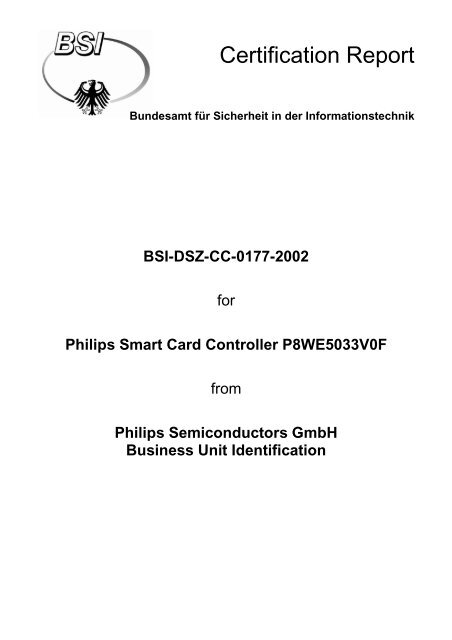
![[ST] System z10 EC LPAR Security Target V7.7.2 20081023 PU-205](https://img.yumpu.com/16227170/1/184x260/st-system-z10-ec-lpar-security-target-v772-20081023-pu-205.jpg?quality=85)
